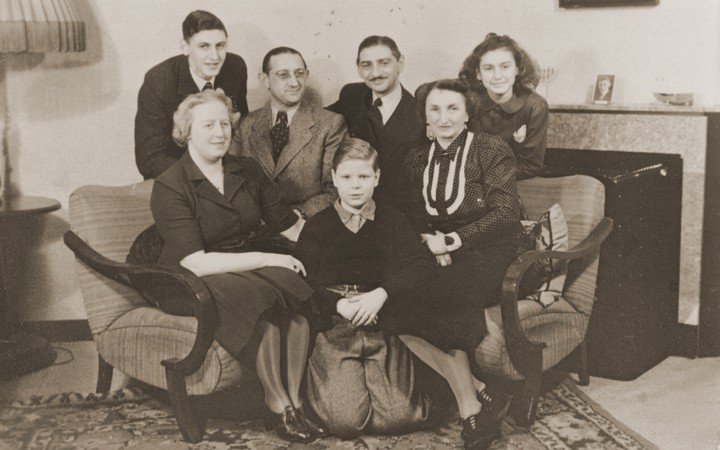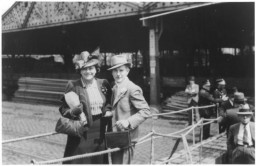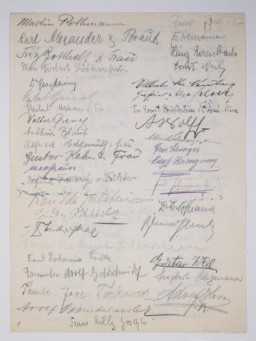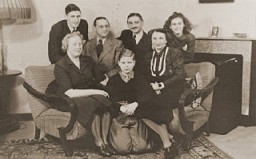
Refuge in Latin America
Most Latin American nations were relatively open to immigrants from 1918 to 1933. After the Nazi seizure of power in Germany, however, as the search for refuge intensified, both popular and official resistance to the acceptance of European Jews and other foreigners increased. Latin American governments officially permitted only about 84,000 Jewish refugees to immigrate between 1933 and 1945, less than half the number admitted during the previous fifteen years. Others entered these countries through illegal channels.
The refusal of Latin American nations to offer admittance to more Jewish refugees stemmed from many causes. Growing antisemitism was undoubtedly one reason, as was fear of economic competition. In certain cases, there was resentment of the fact that some Jewish refugees who were admitted on the condition that they work in agricultural regions later drifted to the cities. In addition, the sympathy of some Latin Americans of German descent for Nazi ideology and racial theories also contributed to increasing antisemitism.
During the Great Depression, political leaders and governments throughout the region exploited the economic crisis to develop populist bases. The policies of rulers such as Getulio Vargas (Brazil), Roberto Ortiz (Argentina), Arturo Alessandri (Chile), Lazaro Cardenas (Mexico), and Fulgencio Batista (Cuba) reflected this trend, which encouraged the development of anti-immigrant political parties or platforms and strong press campaigns against immigration. These attitudes were reflected in increasingly tight immigration laws introduced throughout Latin America in the late 1930s (Mexico in 1937; Argentina in 1938; Cuba, Chile, Costa Rica, Colombia, Paraguay, and Uruguay in 1939). The results of these laws were striking. Argentina, which had admitted 79,000 Jewish immigrants between 1918 and 1933, officially admitted 24,000 between 1933 and 1943. Another 20,000 Jews entered Argentina illegally, crossing the border from neighboring countries. Brazil admitted 96,000 Jewish immigrants between 1918 and 1933, but only 12,000 between 1933 and 1941.
In this climate, Cuban authorities denied entry to most passengers on the ship the St. Louis, when it docked in Havana in May 1939. While the St. Louis carried an unusually large number of would-be immigrants and was accompanied by significant media attention, the incident was not isolated. Passengers on the ships Orduña, Flandre, and Orinoco were caught in a similar bind. In November 1941, the German government virtually cut off the flow of Jewish refugees into Latin America when it banned all Jewish emigration from territories under its control.
Non-Jews found it easier to immigrate to some Latin American nations. Mexico admitted only 1,850 Jewish refugees between 1933 and 1945, but issued at least 16,000 immigration visas to Spanish loyalist refugees between 1938 and 1945, and over 1,400 visas to Catholic Polish refugees between 1939 and 1941. Brazil proposed to take in several thousand non-Jewish refugees from Finland and German controlled territory, including Catholics defined as “non-Aryans” under the Nazi racial classification system.
There were exceptions to this chilly reception. At the international Evian Conference on the refugee crisis, only the Dominican Republic agreed to accept additional refugees, on condition that they had the means to "contribute to the country's enrichment." This offer came as President Rafael Trujillo sought both to rehabilitate his reputation following his government's massacre of Black Haitians in 1937 and to bring white wealth into his country. The Dominican government subsequently donated land in Sosúa, a city on the island's northern coast, for the establishment of a Jewish agricultural settlement. Despite backing from US President Franklin D. Roosevelt and the American State Department, and the investment of considerable sums of money by Jews in the United States, the Dominican Republic admitted only 645 Jews from 1938 to 1945 and the population of the Sosúa colony peaked at 476 residents in 1943. Nevertheless, the Dominican authorities issued around 5,000 visas to European Jews between 1938 and 1944, although a majority of the recipients never settled in the Dominican Republic. Still, these documents were central to their ability to flee Nazi occupied Europe.
Less well-known is the admission of more than 20,000 Jewish refugees between 1938 and 1941 to the Andean nation of Bolivia. Decisive in this enterprise were the efforts of Mauricio (Moritz) Hochschild, a German-Jewish mining magnate who controlled one-third of Bolivia's mineral production and had political ties to Bolivian President Germán Busch. Following the Chaco War with Paraguay (1932-1935), Busch sought to revive the Bolivian economy by admitting European immigrants. Hochschild used this opening to facilitate a regular flow of German and Austrian Jewish immigrants, who obtained visas provided by five Bolivian consulates in Europe (Zurich, Paris, London, Berlin, and Vienna). The refugees arrived by ship in Arica, Chile, where they were taken by train to La Paz, Bolivia, in what became known as the Express Judio (“Jewish Express”). With the help of the US-based American Jewish Joint Distribution Committee, Hochschild established facilities for the immigrants, many of whom subsequently traveled illegally across Bolivia's porous borders into neighboring countries, especially Argentina. (Hochschild's Sociedad de Protection a los Immigrantes Israelitas or SOPRO had offices in La Paz, Cochabamba, Potosi, Sucre, Oruro, and Tarija.)
Mexican diplomat Gilberto Bosques Saldivar also played an important role in rescuing Jews. As a consul in Marseille, a port city in what became Vichy France, Bosques directed consular officials to issue a visa to any refugee who wished to flee to Mexico. His efforts saved the lives of tens of thousands of Jews and refugees fleeing the Franco dictatorship in Spain. Bosques also rented a castle and a summer holiday camp near Marseille to house refugees, claiming that under international law, the property constituted Mexican territory. In 1943, the Gestapo arrested Bosques, his family, and 40 consular staff and detained them in Germany for a year until the Mexican government obtained their release through a prisoner exchange. After the war, Bosques would go on to serve as ambassador of Mexico to several countries and played an influential role in resolving the 1962 Cuban Missile Crisis.
After Nazi Germany and its Axis partners began to implement the mass murder of the European Jews in 1941, some Latin American governments issued passports, visas, and citizenship papers through their European legations. These documents played an important role in the rescue of Jews, although many never actually reached the nations that issued the papers. Nevertheless, these documents often enabled them to begin the journey to safety. Beginning in 1942, El Salvador made up to 20,000 passports available to Jews under Nazi occupation through its Consul General in Geneva, José Arturo Castellanos . These passports were especially useful in saving lives in Budapest in 1944, when Hungarian Jewry was the last intact Jewish community in occupied Europe.
Latin America was an important destination for many survivors after the Holocaust. More than 20,000 Jewish displaced persons (DPs) immigrated to the region between 1947-1953. Their primary destination was Argentina, which became home to at least 4,800 Holocaust survivors. Others settled in Brazil, Paraguay, Uruguay, Panama, Costa Rica, among other countries.
Critical Thinking Questions
- What pressures and motivations may have affected Latin American leaders as they considered admitting Jewish refugees?
- Compare the policies of Latin American countries with United States policy. What are some similarities and differences?



